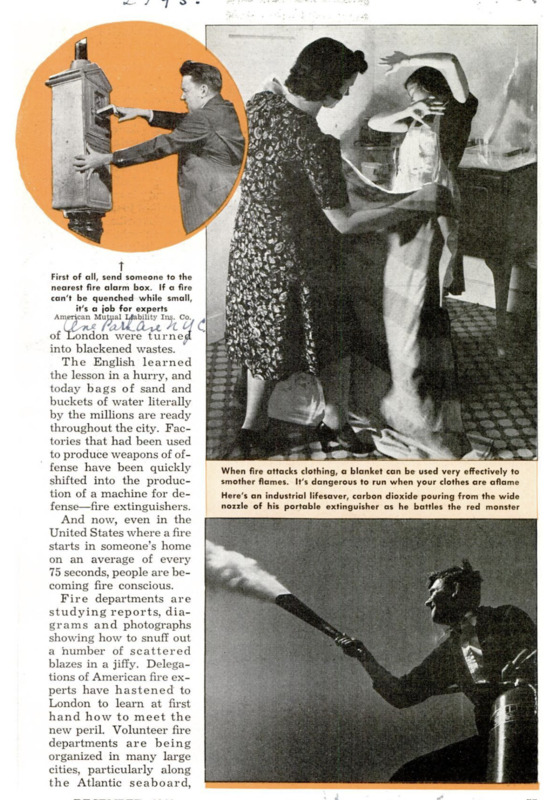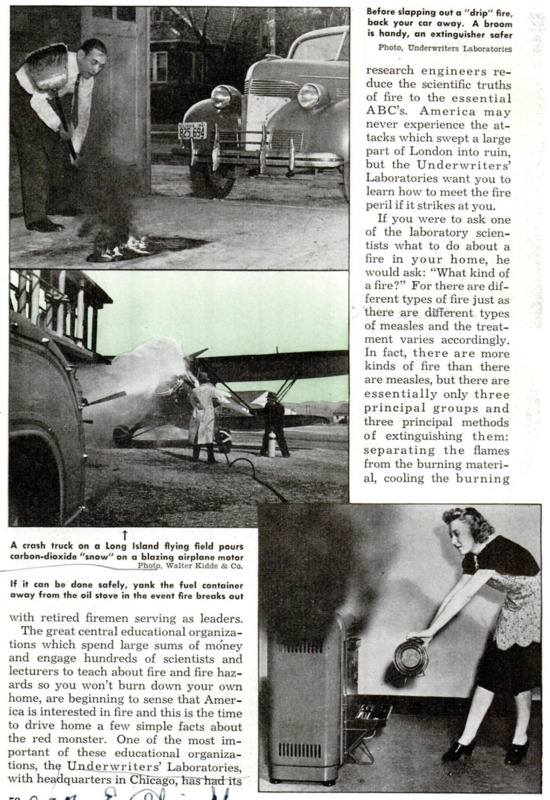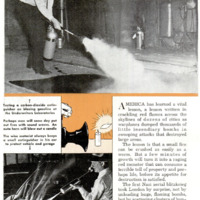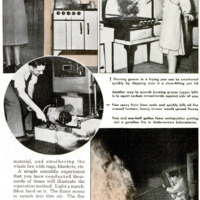AMERICA has learned a vital lesson, a lesson written in crackling red flames across the skylines of dozens of cities as warplanes dumped thousands of little incendiary bombs in swooping attacks that destroyed large areas. The lesson is that a small fire can be crushed as easily as a worm. But a few minutes of growth will turn it into a raging red monster that can consume a terrible toll of property and perhaps life, before its appetite for destruction is satisfied. The first Nazi aerial blitzkrieg took London by surprise, not by unloading huge, flaming bombs, but by scattering clusters of hundreds of little insignificant fellows, most of which could have been snuffed out by a pail of sand, or a few buckets of water. Unfortunately, the sand and water were not available in sufficient quantity and great sections of London were turneg into blackened wastes. The English learned the lesson in a hurry, and today bags of sand and buckets of water literally by the millions are ready throughout the city. Factories that had been used to produce weapons of offense have been quickly shifted into the production of a machine for defense - fire extinguishers. And now, even in the United States where a fire starts in someone’s home on an average of every 75 seconds, people are be- coming fire conscious. Fire departments are studying reports, diagrams and photographs showing how to snuff out a number of scattered blazes in a jiffy. Delegations of American fire experts have hastened to London to learn at first hand how to meet the new peril. Volunteer fire departments are being organized in many large cities, particularly along the Atlantic seaboard, with retired firemen serving as leaders. The great central educational organizations which spend large sums of money and engage hundreds of scientists and lecturers to teach about fire and fire hazards so you won't burn down your own home, are beginning to sense that America is interested in fire and this is the time to drive home a few simple facts about the red monster. One of the most important of these educational organizations, the Underwriters' Laboratories, with headquarters in Chicago, has had its research engineers reduce the scientific truths of fire to the essential ABC's. America may never experience the attacks which swept a large part of London into ruin, but the Underwriters’ Laboratories want you to learn how to meet the fire peril if it strikes at you. If you were to ask one of the laboratory scientists what to do about a fire in your home, he would ask: “What kind of afire?” For there are different types of fire just as there are different types of measles and the treatment varies accordingly. In fact, there are more kinds of fire than there are measles, but there are essentially only three principal groups and three principal methods of extinguishing them: separating the flames from the burning material, cooling the burningi material, and smothering the whole fire with rugs, blankets, etc, A simple scientific experiment that you have conducted thousands of times will illustrate the separation method. Light a match. Blow hard on it. The flame seems to vanish into thin air. The fire is out. Aviators use this method when their motors catch fire, either opening their throttles wide and sucking the flame into the motor before the flames generate more. inflammable gas; or by going into a steep dive. You can’t blow out many types of fire in your home, but you can often separate the flames by beating them off with a small rug, a blanket, or a wet towel, or if they are in a garment, by whipping the garment against the bare wall or floor. But the most common type of fire in the home is one where wood, paper, rubbish or textiles are burning. Here, cooling with water is most effective. Or you might have a rapidly burning fire caused by the ignition of gasoline, grease or oil. In that case the preferred treatment would be smothering - cutting off its oxygen supply. A third type is the fire in electrical equipment. Here either smothering or cooling could be employed, provided you did not use water or any other extinguishing agent which will conduct electricity and shock yourself, but first of all, disconnect the appliance, if possible. Sometimes a fire may need a combination of two extinguishing methods. Let's take an imaginary trip through a house with one of the experts from Underwriters’ Laboratories and find out just what might happen. And let’s presume that as we reach this house the engine of our car catches fire. He would stop the car, grab a one-quart extinguisher, open the car hood and direct the stream against the engine 'so that it could splash against the hot surfaces, evaporate and form gas. The gas would smother the fire. If there were no extinguisher in the car, he would throw dirt on the engine, or sand or snow, again smothering the flames, or beat the fire out with a hat or coat, separating the flames from the burning material. If the car caught fire in the garage and the fire spread to grease and oil on the floor, he would try to get the car out of the garage, put out the fire in the car first with the extinguisher, and then attack the fire in the garage floor with the remaining liquid. And if there were no extinguisher on hand, the expert would use sand, dirt or even a broom. Many fires start in basements, so we go there next. Fires in the basement are dangerous because they are below you and can spread throughout the house. A good extinguisher to have in the basement to fight oil fires or rubbish or wood fires, the expert explains, is the two and one-half gallon foam type. Suppose we have a leaking oil line and the floor around the furnace is covered with flaming oil. By inverting the foam extinguisher and directing the stream upon the surface of the flaming oil, the fire may be extinguished. If it is not possible to put the fire out completely, at least the smothering blanket of foam will greatly reduce the fire’s intensity and retard the spread of the flames. If we do not have an extinguisher, a good quantity of sand which can be shoveled or thrown on the flaming oil is effective. And a garden hose adjusted to a fine spray can be used to cool the fire and to wet down the area surrounding it. Under no conditions should a forceful water stream be directed into flaming oil. That would spread the fire. With a rubbish or wood fire the hose can also be used and a strong stream is effective here. Buckets or pans of water may help if a hose is not available. Remember, the expert cautions, when there is a fire in the basement, or anywhere in the house, the whole house is in danger. Call for help and have someone call the fire department. And if you're alone, phone the fire department immediately, unless you have extinguishers or other equipment and are certain of being able to put out the blaze without help. If the fire gets out of hand and you have delayed calling the fire department, the damage may be great. Now we go to the kitchen, where, he says, we usually have grease fires. Frying doughnuts in a large kettle of grease sometimes causes fires if the grease is allowed to get too hot. An excellent device for putting out kitchen fires is a two-pound carbon-dioxide extinguisher that can be handled easily by a woman. It smothers the fire with carbon dioxide gas and snow which is at a temperature of one hundrad and ten degrees below zero. The next best thing is a large pot lid to put over the kettle or skillet and smother the flames. In the rest of the house we are mostly concerned with a fire in cushions, bedding, or rugs which does not usually spread rapidly and can generally be put out with buckets of water if discovered soon enough. For that sort of fire, any kind of extinguisher would be helpful. But a two and one-half gallon soda-acid extinguisher, or a water pump type would be best. The expert tells us that for ordinary fires, attack from the windward side, and extinguish the flames from the bottom up, or from the front back. Try to keep the fire from flashing back over the area which has been extinguished. In the case of burning liquids in open containers, the stream from the extinguisher should be directed against the inside wall of the container so that it will spread back over the liquid. Never turn the stream into the flaming liquid; it may spread the fire. Carbon dioxide and some other types of extinguishers should be used with a sweeping motion for they separate the flame from the burning material. Using the extinguisher cor- rectly may make the difference between success or failure. Above all, do not give up. One instant it may look hopeless, the next you may have the fire out. The important thing is to keep a clear head and act quickly.








